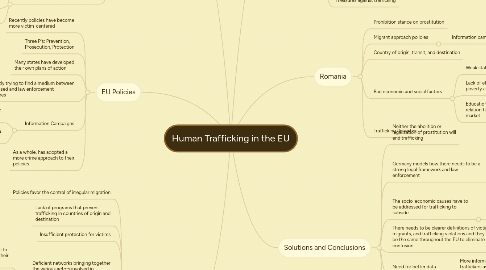
1. Human Trafficking
1.1. The exploitation of human beings
1.1.1. modern day slavery
1.2. All of Europe is affected
1.2.1. Been on the rise since the end of the East-West conflict
1.2.2. The countries of the former Soviet Union, The Balkans, have turned into transit, origin, and destination countries
1.2.3. Low risks and massive profits for the traffickers
1.2.4. Trafficking is largely under-reported, which leads to it being under-detected and under prosecuted
1.2.5. Reasons for people to end up in the hands of traffickers: poverty, violence in home country, lack of opportunities, ethnic wars, dictatorships
1.2.6. Call for more victim-centered legislation
1.3. Different ways to address trafficking
1.3.1. Gender viewpoint
1.3.2. Migration viewpoint
1.3.3. Law enforcement viewpoint
2. EU Policies
2.1. Recently policies have become more victim-centered
2.2. Three P's: Prevention, Prosecution, Protection
2.3. Many states have developed their own plans of action
2.4. Constantly trying to find a medium between rights-based and law enforcement approaches
2.5. Information Campaigns
2.5.1. viewed as essential tool for fighting trafficking
2.5.2. target young women in Eastern and Central Europe
2.6. As a whole, has adopted a more crime approach to their policies
3. Critiques of EU
3.1. Policies favor the control of irregular migration
3.2. Lack of programs that prevent trafficking in countries of origin and destination
3.3. Insufficient protection for victims
3.4. Deficient networks bringing together the various actors involved in trafficking
3.4.1. Actors are unwilling or unable to synchronize and coordinate their work
3.4.2. This keeps them from presenting a unified front against trafficking
3.5. Blurry lines between guilty migrant and innocent victim
3.6. Derogatory view of migrant women and women who choose to be sex workers
3.7. Ambiguity
3.8. Neglect of social and economic causes that lead people to migrate
3.9. Information campaings
3.9.1. Use trafficking to prevent migration
3.9.2. Generate confusion between trafficking and migrating
3.10. Unclear status and definition of trafficked victims
3.10.1. definitions of trafficked victims differ from state to state
4. Germany
4.1. Legalization of Prostitution
4.1.1. Sex workers have access to health care and benefits
4.1.2. Sex workers are able to organize and fight issues pertaining to them
4.1.3. Provides training for workers that are looking for alternatives
4.2. Victim-based policies
4.2.1. Victim's Compensation Act
4.3. One of the most powerful states in the EU: largest population and strongest economy
4.4. Strict punishments for offenders, but not for victims
4.5. Works to fight trafficking abroad
4.6. Pattern of decrease of trafficking
4.7. Strong law enforcement measures against trafficking
5. Romania
5.1. Prohibition stance on prostitution
5.2. Migrant approach policies
5.2.1. Information campaigns
5.3. Country of origin, transit, and destination
5.4. Bad economic and social factors
5.4.1. Weak state with high levels of corruption
5.4.2. Lack of efficient policies to fight poverty and lack of employment
5.4.3. Educational system is deficient in relation to the requirements for the job market
5.5. Trafficking flourishes
6. Solutions and Conclusions
6.1. Neither the abolition or legalization of prostitution will end trafficking
6.2. Germany models how there needs to be a strong legal framework and law enforcement
6.2.1. Currently strong preventative methods are only taken by richer countries
6.2.2. EU needs to step in and help the poorer countries
6.3. The socio-economic causes have to be addressed for trafficking to subside
6.3.1. There needs to be policies creating economic opportunities in countries of origin
6.4. There needs to be clearer definitions of victims, migrants, and trafficking violations and they need to be the same throughout the EU to eliminate the confusion
6.4.1. There has to be clear distinction between migration and trafficking policies.
6.5. Need for better data
6.5.1. More information is needed about the traffickers as well as the demand side of trafficking
6.6. The biggest hope for ending trafficking lies in collaboration
6.6.1. Switch from government to the theory of governance
6.6.2. There needs to be much more cooperation between actors
6.6.3. There needs to be transnational policies so that states can take the same stance
6.6.4. States must work with NGOs, IOs, and private actors. Need for multi-faceted approach.
